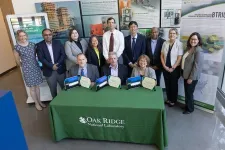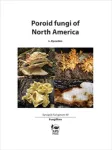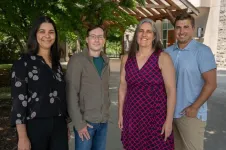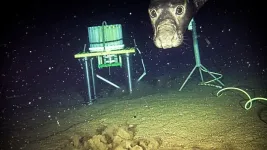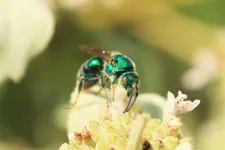(Press-News.org) DURHAM, N.C. – A treatment paradox has recently come to light in prostate cancer: Blocking testosterone production halts tumor growth in early disease, while elevating the hormone can delay disease progression in patients whose disease has advanced.
The inability to understand how different levels of the same hormone can drive different effects in prostate tumors has been an impediment to the development of new therapeutics that exploit this biology.
Now, a Duke Cancer Institute-led study, performed in the laboratory of Donald McDonnell, Ph.D. and appearing this week in Nature Communications, provides the needed answers to this puzzle.
The researchers found that prostate cancer cells are hardwired with a system that allows them to proliferate when the levels of testosterone are very low. But when hormone levels are elevated to resemble those present in the normal prostate, the cancer cells differentiate.
“For decades, the goal of endocrine therapy in prostate cancer has been to achieve absolute inhibition of androgen receptor function, the protein that senses testosterone levels,” said lead investigator Rachid Safi, Ph.D., research assistant professor in the Department of Pharmacology and Cancer Biology, at Duke University School of Medicine.
“It’s been a highly effective strategy, leading to substantial improvements in overall survival,” he said. “Unfortunately, most patients with advanced, metastatic disease who are treated with drugs to inhibit androgen signaling will progress to an aggressive form of the disease for which there are limited therapeutic options.”
Using a combination of genetic, biochemical, and chemical approaches, the research team defined the mechanisms that enable prostate cancer cells to recognize and respond differently to varying levels of testosterone, the most common androgenic hormone.
It turned out to be rather simple. When androgen levels are low, the androgen receptor is encouraged to “go solo” in the cell. In doing so, it activates the pathways that cause cancer cells to grow and spread. However, as androgens rise, the androgen receptors are forced to “hang out as a couple,” creating a form of the receptor that halts tumor growth.
“Nature has designed a system where low doses of hormones stimulate cancer cell proliferation and high doses cause differentiation and suppress growth, enabling the same hormone to perform diverse functions,” McDonnell said.
In recent years, clinicians have begun treating patients with late-stage, therapy resistant prostate cancers using a monthly, high-dose injection of testosterone in a technique called bi-polar androgen therapy, or BAT. The inability to understand how this intervention works has hindered its widespread adoption as a mainstream therapeutic approach for prostate cancer patients.
“Our study describes how BAT and like approaches work and could help physicians select patients who are most likely to respond to this intervention,” McDonnell said. “We have already developed new drugs that exploit this new mechanism and are bringing these to the clinic for evaluation as prostate cancer therapeutics.”
In addition to McDonnell and Safi, study authors include Suzanne E. Wardell, Paige Watkinson, Xiaodi Qin, Marissa Lee, Sunghee Park, Taylor Krebs, Emma L. Dolan, Adam Blattler, Toshiya Tsuji, Surendra Nayak, Marwa Khater, Celia Fontanillo, Madeline A. Newlin, Megan L. Kirkland, Yingtian Xie, Henry Long, Emma Fink, Sean W. Fanning, Scott Runyon, Myles Brown, Shuichan Xu, Kouros Owzar, and John D. Norris.
The study received funding support from the National Cancer Institute (R01-CA271168, P30CA014236) and the North Carolina Biotechnology Center.
###
END
New research published in the Journal of Sport and Health Science led by the University of Massachusetts Amherst shows that super spikes, scientifically described as advanced footwear technology (AFT) spikes, can give runners about a 2% edge in middle-distance track races, like the 800- and 1,500-meters.
“Track athletes started wearing super spikes about five years ago and they are now commonplace in elite track races,” says Wouter Hoogkamer, assistant professor of kinesiology at UMass Amherst and senior author ...
WASHINGTON, D.C. -Ten Energy Frontier Research Centers (EFRCs) designed to bring together world-class teams of scientists for groundbreaking fundamental research have been funded in nine states by the U.S. Department of Energy (DOE).
Since 2009, EFRCs have brought together diverse, world-class teams of scientists to perform basic research that accelerates ground-breaking scientific advances underlying energy technologies.
The centers develop powerful new tools for characterizing, understanding, modeling, and manipulating matter, while training the next-generation scientific workforce by attracting talented students passionate about energy science.
“Fundamental ...
The American College of Cardiology (ACC) Quality Summit 2024 will take place on September 17-19 in San Antonio, bringing together cardiovascular leaders from across the nation to discuss the value of NCDR services and quality programs.
“ACC’s Quality Summit puts the spotlight on the value of ACC Accreditation and NCDR services for improving health care quality across all health systems,” said ACC Quality Summit Chair Olivia N. Gilbert, MD, MSc, FACC, and Director of Quality and Value for Cardiovascular Medicine at Atrium Health Wake Forest ...
Flexcon Global has exclusively licensed two patented inventions to manufacture a self-healing barrier film from the Department of Energy’s Oak Ridge National Laboratory for research and development purposes. The film can be incorporated into vacuum insulation panels to increase the efficiency of buildings during retrofits.
Flexcon, based in Spencer, Massachusetts, provides coatings, film laminations and functional technologies to a range of markets including healthcare, sustainable packaging, transportation, consumer durables, electronics, industrial, retail and advertising.
Under ...
Poroid fungi, commonly known as "polypores," are among the most frequently encountered fungi throughout the year because of their large size and longevity. Despite the common presence of poroid fungi in North America, most guides include only a limited selection of these fungi. Poroid Fungi of North America, by Leif Ryvarden, offers a necessary, updated account of these fungi, building on the foundational work of the original two-volume North American Polypores, by Ryvarden and R. L. Gilbertson, published in 1987. This comprehensive update incorporates more than three decades of new research, featuring detailed keys, descriptions, and vibrant color ...
Four faculty members from three departments in the College of Natural Resources and Environment have received $1.7 million from the National Science Foundation to fund research into the dynamics of socio-environmental factors impacting coastal fisheries.
Holly Kindsvater and Willandia Chaves of the Department of Fish and Wildlife Conservation, Craig Ramseyer of the Department of Geography, and Michael Sorice of the Department of Forest Resources and Environmental Conservation will collaborate with Jonathan van Senten and Fernando Gonçalves of the Virginia Seafood Agricultural Research ...
Wildfires leave potent climate heaters behind in their wake, particles that enhance the absorption of sunlight and warm the atmosphere. Dropped on snow like a wool poncho, these aerosols darken and decrease the surface reflectance of snowy places.
But it was not yet understood just how different types of smoke particles contribute to these effects. In a study recently published in npj Climate and Atmospheric Science, researchers at Washington University in St. Louis model how dark-brown carbon (d-BrC) – light absorbing, water insoluble organic carbon – from wildfires plays a much larger role as a snow-warming agent than previously recorded. ...
Young male northern elephant seals are captured on camera returning to a deep sea cabled observatory off Canada's British Columbia coast, demonstrating new insight into fish foraging behavior
###
Article URL: https://journals.plos.org/plosone/article?id=10.1371/journal.pone.0308461
Article Title: Deep-sea cabled video-observatory provides insights into the behavior at depth of sub-adult male northern elephant seals, Mirounga angustirostris
Author Countries: Canada, USA, Spain
Funding: Ocean Networks Canada (ONC) is funded through the Canada Foundation for Innovation-Major Science Initiative ...
This release has been removed per request of the submitting organization due to a duplicate submission. You can find the embargoed release here: https://www.eurekalert.org/news-releases/1055807
For more information, please contact: Charlotte Bhaskar, cbhaskar@plos.org END ...
A diverse and abundant flower planting that provides flowers in bloom all season may be more important to bees and other pollinators than whatever is surrounding the flower garden, according to a study published September 4, 2024 in the open-access journal PLOS ONE by Devon Eldridge from the University of Tennessee, US, and colleagues.
As we learn more about how critical pollinators (native and non-native bees, butterflies, and other insects) are to our food supply and ecosystem, many people are planting pollinator-attractive ...

